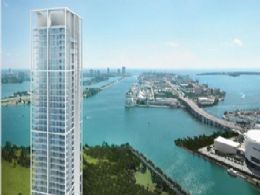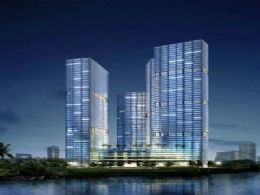|
High-rises, high hopes
BY ANDRES VIGLUCCI AND MATTHEW HAGGMAN
aviglucci@herald.com
COURTESY OF THE TERRA GROUP
BIG PLANS: In 2005, this rendering of the condo tower was envisioned for the area behind the historic Freedom Tower.
In downtown, from Brickell Avenue north to the Edgewater neighborhood, up the Miami River and down historic Coral Way, great chunks of Old Miami are fast disappearing in a cloud of dust. In its place, the New Miami -- a dense, steel-and-glass forest of condo towers -- is rising from the rubble.
The scope, scale and speed of the transformation are breathtaking. More than 114 major projects, most of them high-rise condos, are under construction or in the planning stages in the urban core along Biscayne Bay.
Citywide, developers are proposing more than 61,000 new condominium units -- eight times the number built during the past decade.
The projects encompass the tallest skyscraper in Florida, a 74-story spire higher than any residential building south of Manhattan, almost four million square feet of new retail space (nearly as much as two Aventura Malls) and parking for more than 100,000 cars.
''You have a wave of development underway here in Miami that is unprecedented, bigger than anything, bigger than Hong Kong in the boom years of development,'' said former Portland, Ore., councilman Charles Hales, a transportation consultant working on a plan for a Miami streetcar line.
Not since the post-World War II housing boom that multiplied Miami-Dade County's population fivefold, to more than one million people, has the region experienced anything comparable. But that took almost 20 years.
''We are building an instant city; what should take 15 years will take three,'' said Michael Cannon, a Miami real-estate analyst. The boom struck suddenly, unexpectedly, first a trickle of projects, then a torrent. Cash has poured in from Latin America, New York and, increasingly, Europe, the result of converging market forces -- slashed interest rates, a cheap dollar -- and a worldwide infatuation with Miami among the chic and moneyed.
It all amounts to a multibillion-dollar gamble, outdoing in risk and bravado the 1920s boom that made Miami a modern city: That given waterfront location, a sunny climate and a hip, international culture, intensive downtown residential development can catapult Miami into the first rank of world cities.
Elected officials, in particular Miami Mayor Manny Diaz and Miami Commissioner Johnny Winton, are counting on the boom to reverse downtown's long decline, to turn its seedy blocks and outlying neighborhoods into a scintillating, working urban hub with a vibrant street life.
''Just five years ago we were broke; we had zero development,'' Winton said. ``I'm going to bet you that when we're done -- I don't know when that will be -- historians will identify this as the most significant and rapid transformation of an American city.''
What precisely will the boom deliver? It's too soon to tell, experts say.
But this convulsion of development is already remaking not just Miami's skyline, but its streets and neighborhoods and likely its population, too.
If it stays on track, the boom promises a fundamentally different Miami -- more urban and congested, but also more cosmopolitan and, given the high prices the condos command, probably wealthier.
It also raises serious concerns. In the absence of a ready plan, how will the city cope with thousands of expected new residents and the traffic they will generate, given antiquated infrastructure, limited public transit and a shortage of parks and open space? Will Miami residents, among the nation's poorest urban dwellers, be displaced or priced out of new housing?
That is, if the planned condos actually get built, sold and occupied.
As the boom takes on the feel of a gold rush, real estate analysts, bankers and even some developers fear it's a mirage, a bubble fueled by speculators looking to resell condo units for a quick profit, and not by true buyer demand.
If developers build too much, and speculators can't find buyers for resale, the boom could bust, leaving Miami littered with vacant and bankrupted buildings or, worse, unfinished towers and bare lots.
SIGNS OF FUROR
For now, though, signs of the furor are everywhere.
Sales centers for multimillion-dollar condos that tout the merits of high-rise living sprout up across the city. Brokers push Miami condos in farflung locales, from Caracas and Bogotá to New York and France's Cte d'Azur. Lavish condo parties are thrown by developers several times a week, and advertisements for the high-rises fill the pages of local magazines and newspapers, including The Herald.
Downtown Miami is a thicket of construction cranes. Much of the landward side of Biscayne Boulevard has been razed, and the footings and columns of what will soon be a wall of six colossal condos, each more than 50 stories, are becoming visible.
''Where else are you near the water, 10 minutes from Miami Beach, 15 minutes from the airport and have access to public transportation?'' said Daniel Kodsi, chief executive of Boca Raton-based Royal Palm Communities, which plans a high-rise condo called Paramount Park across from AmericanAirlines Arena.
There is so much building that developers are struggling to find qualified contractors and subcontractors.
Sales and resales in the mid-six figures, and well beyond, have become commonplace. Towers of 300 units sell out in a day, with buyers coming in the main not from Miami, but from other parts of the country and the world.
''Miami, New York and Los Angeles have become the three cities in the U.S. where people want to be,'' said Joe Cayre, chairman of Midtown Group, which is building eight condo towers on the site of the old Florida East Coast Railroad yards in Wynwood.
They are people like Sal Loduca, who plans to leave Manhattan and his family's Long Island food business to open a brick-oven pizzeria at Cayre's Midtown Miami.
''Everyone's making the move to Miami. How could you not? It's a great opportunity. Miami's full of life,'' Loduca said.
`CRITICAL COMBUSTION'
Real estate broker Philip Spiegelman calls the confluence of factors propelling this boom a ``critical combustion.''
Among them:
• Across the country, young people and so-called ''empty-nesters'' have been returning to urban centers, in part because of long, wearing commutes from outlying suburbs. At the same time, a dwindling supply of easily developable land in western Miami-Dade and Broward counties has prompted developers to look eastward.
• A shortage of waterfront property elsewhere led developers to Miami's acres and acres of vacant bayfront land.
• Low interest rates have fueled record home-buying, while aging baby boomers are increasingly seeking second homes in sunny or exotic places.
• A cleaner local government has made Miami attractive to lenders and investors who once thought the city too risky, unsafe or corrupt.
• The weak dollar has made Miami an alluring bargain for Europeans and Latin Americans. And compared to other urban centers like New York City, Miami remains cheap.
Then there is the other factor, anecdotal and unquantifiable: the speculator.
''As much as 85 percent of all condominium sales in [downtown Miami] are accounted for by investors and speculators,'' housing analysts at investment firm Raymond James warned in a March report.
Banks have started to back off lending on condo projects, or have instituted new rules to avoid giving mortgages to investors.
Spiegelman sold the condo units in the Marina Blue condo going up on Biscayne Boulevard.
''One hundred percent of the buyers were investors and speculators,'' he said. ``Anyone who tells you their projects are different are deluding themselves.''
ZONING-CODE OVERHAUL
The pace of development is so furious that it has overtaken the city's planning efforts.
Only now is the city getting around to a long-promised overhaul of its outdated zoning code, a complete rewrite meant to ensure that new development produces lively, pedestrian-friendly streetscapes and respects open spaces and established neighborhoods, while weaving it all together into a cogent urban fabric. The rewrite, dubbed Miami 21, will be phased in over two years.
Yet more than 100 large-scale projects, most of them in and around downtown, have already been approved or are under construction.
Public-transit improvements like Metrorail extensions, a light-rail line to Miami Beach and the contemplated city streetcar are years away, raising fears of gridlock.
Quipped Cannon, the real estate analyst: ``Maybe we need to give every buyer of a condo in the urban core a Segway.''
There are other worries.
Some skeptics, noting the high condo prices and the out-of-town provenance of buyers, fear that instead of the diverse, working 24-hour downtown that city leaders envision, the boom will instead create a seasonal playground for the rich, a Monte Carlo on Biscayne Bay.
''I bet those buildings are going to be empty a lot of the time,'' said Joel Kotkin, an urban historian and consultant who has written about the rise of what he calls ''ephemeral cities'' -- places like San Francisco, Berlin and parts of New York that increasingly cater to the rich, the childless young and tourists.
''Maybe this is Miami's karma, to be this kind of place, a temporary, hip, cool, nomadic population serviced by a poor population,'' said Kotkin, author of The City: A Global History. But, he added: ``History shows a city has to maintain some sense of a middle-class character if it wants to thrive.''
`MISSING LINK'
Yet there's relatively little in the new downtown priced for working families. ''The missing link here is in creating housing that the middle class can afford,'' said Rafael Kapustin, a longtime downtown property owner who pioneered the conversion of old downtown offices and hotels into modestly priced condos and apartments.
In partnership with a big developer, the Related Group, Kapustin developed two affordable loft condos, with units averaging around $150,000, now under construction in the inner core of downtown. But their Loft II project may be the last of its kind because of the surging cost of land and construction, he said.
City leaders are sanguine. They say it will take years for all the planned condos to be built and occupied, allowing time to absorb new residents, build public amenities and improve transit.
While few city residents can afford waterfront condos, thousands of moderately priced condos and rental apartments are being built by private developers in adjacent Overtown and neighborhoods like Little Havana and Allapattah, many with direct city subsidies, according to a recent report from Miami Mayor Diaz.
`SELF-REINFORCING CYCLE'
And gradually, as new residents move into downtown, businesses, shops, restaurants, neighborhood retailers and services will follow, said Neisen Kasdin, a land-use lawyer and former Miami Beach mayor.
''It becomes a self-reinforcing cycle,'' Kasdin said. ``Yes, there will be a large segment of temporary residents, but as the city continues to grow as an international business city, it leads to the continued growth of a permanent community.''
Meanwhile, the city has instituted measures that strengthen the planners' hand in shaping an attractive, livable downtown: hiding parking garages inside buildings; lining sidewalks with shops, offices, dwellings and restaurants; and keeping garage and service entrances off Biscayne Boulevard and other main arteries.
'We used to sit here and say, `Someday,' '' said Miami Planning Director Ana Gelabert-Sánchez, alluding to the city's long-frustrated hopes for a downtown revival. ``Well, someday is here.''
Herald staff writer Larry Lebowitz contributed to this report.
|




















